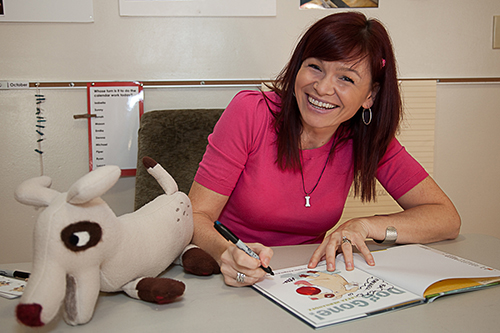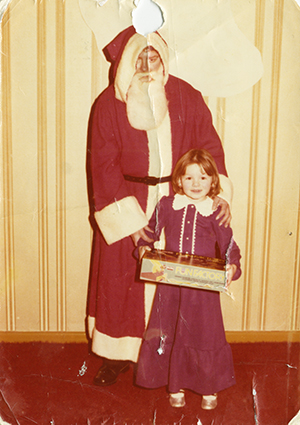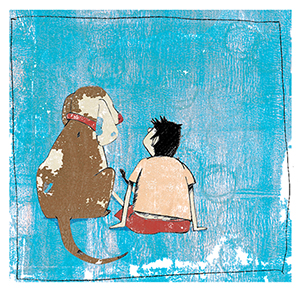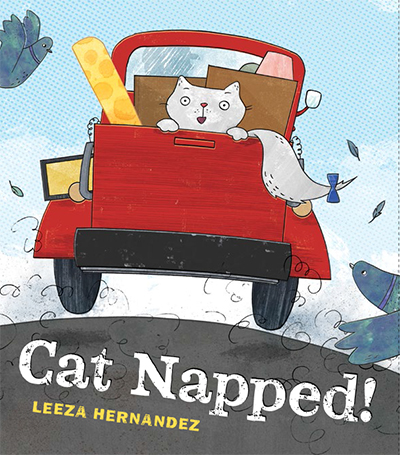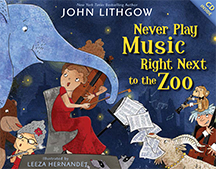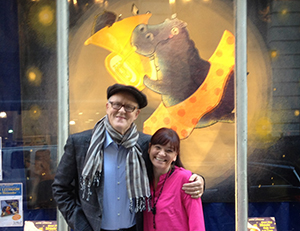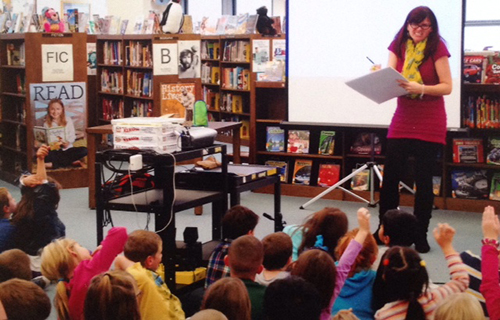Photo by Linda Littenberg
I am thrilled beyond words to be doing this interview today. I met Leeza at last year’s annual NJ SCBWI conference, but have been fortunate enough to have sat in on some of her amazing workshops at past SCBWI conferences.
Award-winning illustrator and children’s book author, Leeza hails from the south of England, but has been living in New Jersey since 1999. In 2004, she switched from newspaper and magazine design to children’s books, and has never looked back. With a few books now under her belt, she’s currently working on a follow up to Dog Gone! called Cat Napped! and a sequel to Eat Your Math Homework, called Eat Your Science Homework (both titles are due for release in 2014). Leeza also illustrated, Never Play Music Right Next to the Zoo, written by acclaimed actor and author John Lithgow.
Leeza is the current Regional Advisor for the New Jersey SCBWI chapter.
Leeza, thanks so much for joining me today. Let’s start at the beginning. How did you get started writing and illustrating?
Hi Robin, thanks so much for having me! Okay, so art came first. It’s cliché but art has been a part of my life since I was a baby. My mum jokes that I fell out of the womb with crayons and paper in my hand! I loved anything that involved making art such as Playdoh, Fashion Wheel, Etch-A-Sketch, and Spirograph—I still do—and I had my parents’ support. They always made art materials available to me. The writing came only a few years ago, though, and I confess it’s hard. I love to tell stories but feel like a clunky novice when I sit down to write.
Me with Santa receiving a Playdoh set aged five years old.
What led you to switch from newspaper and magazine design to children’s books?
The switch came in the early 2000s. As much as I loved working in editorial, I wasn’t being as creatively challenged in my day-to-day work, so I looked for another outlet. Blogging, which was the new trend back then, was what led me to Illustration Friday—an online community where a word of the week prompts you to create an illustration.
This was the first Illustration Friday piece (Word prompt: Wisdom) that went
into my children’s book portfolio and got some positive feedback from art directors.
That eventually led me to SCBWI. I was fascinated and knew immediately that I’d found the outlet I’d been looking for. I owe a huge debt of gratitude to SCBWI—because of the connections, members, friends and mentors who have supported and helped me along the way—the organization is an awesome blessing to each of us in this business!
Can you tell us a little bit about your illustration process? Does your process change when you are also writing the text?
In a nutshell: I read a manuscript a few times first and circle key words or components that stand out to me. Sometimes I see a scene play out in my mind like a mini movie. That’s usually a good indicator that I am connecting to the story. I then put the manuscript away for a week or so and go back and do the same thing again. When I have a good sense of where I’m headed visually, I create fairly tight sketches that are approx. 70 percent of the finished book size—that’s what I submit to the publisher. For my own stories I’m a noodler and a doodler—that’s where a lot of my ideas begin. I start by noodling with word play (phrases and alliteration). At the same time, I’ll doodle until a concept or a character emerges. Each book that I’ve worked on to date has presented different challenges in some way or other, but the underlying bones of my process seems to remain the same.
Do you like to work in a particular medium?
I have three preferred mediums now and the tone and content of a project will typically dictate which medium is called for. The first is mixed-media: fusing hand-made textures, stamping, printmaking, collage papers and hand-drawn line into a digital collage. The second is silk-screening/printmaking and the third is pencil.
How long does it generally take you to work on one book? Do you work on more than one book at a time?
In the fall I came out of a 19-month period of working on three picture books: a 32-pager, 40-pager and 48-pager—it was cool but brutal at the same time! I’m not sure I would want that intensity again for a while, although for the most part they staggered okay. Each book project varies in terms of deadlines, schedules, revisions, etc. but generally, the illustration portion of my work on average takes about seven to nine months, from concept to final art. Having said that, I’m currently working on a new book and the illustration turnaround will only be about five or six months.
Do you find it easier to write and illustrate your own books, rather than to work on someone else’s manuscript?
Yes and no. When I write and illustrate my own work, I can make changes to either in order to marry the words and visuals in the best possible way—take a sentence out here, add a spot visual there—but that also means I can overthink the project. I can’t do that with someone else’s writing (nor would I want to), but the fact that the text is already written and approved means that I can focus solely on illustration, and pay all my attention to adding visual depth to the story. I like both ways—they simply hold a different set of challenges.
Do you collaborate at all with the author on a project?
I’ve become great friends with Ann McCallum as a result of working on the Homework books. We have a lot of fun when brainstorming ideas for other books in the series and what new characters we can introduce, but I don’t really get involved with her actual writing nor she with the illustrating. We definitely collaborate on marketing efforts though.
Dog Gone! has been a HUGE success! Can you tell us how it came about?
Dog Gone! was the result of NOT having a dog sample in my portfolio. An art director asked if I could do dogs, so I created this piece.
The story came to me unexpectedly. I played with the word “dog” to inspire the illustration sample—but “Hot Dog,” “Top Dog,” and “Dog Gone It!” led to “Dog Gone!” A story of a puppy that runs away—thus the story was born.
And can you give us the inside scoop on Cat Napped!?
Cat Napped! releases in June, and I am really excited. When I worked on Dog Gone! I knew I wanted to create a cat companion book, and was so happy when my editor acquired it. In fact, if you look in Dog Gone! there’s a scene that maybe suggests a little foreshadowing or wishful thinking on my part! Cats are curious creatures by nature. I’ve had plenty of cats in my life that loved to wander off and ended up having an adventure of some sort or other—which fueled the idea for this book. I think I’m kinda like that too, curious about the world and keen to discover a new adventure.
Yummy recipes + fun math facts + bunnies = SUCCESS for Eat Your Math Homework: Recipes for Hungry Minds, written by Ann McCallum. How did you end up working on this project? And what can readers expect to see in Eat Your Science Homework?
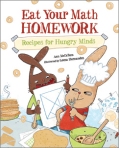 Great question! I attended a Rutgers One-on-One day back in 2007 and had lunch at a table of folks with the then editor from Charlesbridge. We all exchanged business/promo cards and honestly, I didn’t think the editor cared for my work but she was polite enough to take my card.
Great question! I attended a Rutgers One-on-One day back in 2007 and had lunch at a table of folks with the then editor from Charlesbridge. We all exchanged business/promo cards and honestly, I didn’t think the editor cared for my work but she was polite enough to take my card. 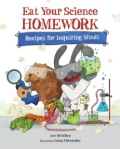 Six months later, my agent forwarded the request for availability from Charlesbridge for a new math book they had acquired and I later discovered that the editor took my card back to the office and looked for a project for me. Turned out she very much wanted to work with me and I am so grateful that she did! You can expect more delicious recipes linked to great experiments, and you’ll see the dufus bunnies back in Science. They’ve donned lab coats and goggles this time in place of aprons and chef hats. There’s another character that breaks some new ground in the book, too.
Six months later, my agent forwarded the request for availability from Charlesbridge for a new math book they had acquired and I later discovered that the editor took my card back to the office and looked for a project for me. Turned out she very much wanted to work with me and I am so grateful that she did! You can expect more delicious recipes linked to great experiments, and you’ll see the dufus bunnies back in Science. They’ve donned lab coats and goggles this time in place of aprons and chef hats. There’s another character that breaks some new ground in the book, too.
There’s been quite a buzz (or maybe it’s more of an excited roar!) about your illustrations in Never Play Music Right Next to the Zoo. (I love the yak playing the sax!) Can you tell us what was your inspiration?
Thank you, Robin, it was such a fun and zany book to work on, although I admit that it took me about five or six weeks to really get my teeth into the sketches. I was very nervous at the beginning and felt a lot of pressure about who the author was. Once I relaxed, I was able to focus on the text and figure out how I could amplify John’s humor with these musically-inclined animals. I role-played so to speak, and posed the question “What if . . . .” I listened to a lot of different styles of music and imagined how each animal might perform when playing their instrument to that music—jazz, blues, classical, etc. A lot of time was spent, too, researching each animal. I’d never heard of a Bonobo monkey before so I got a great education on wildlife during the process.
John Lithgow and me
If your fans would like for you to do a school visit, how can they get a hold of you?
The best way to find out about my school visits is to email leeza@leezaworks.com, subject; School Visit Inquiry. My website is going through a revamp at the moment, which I hope will be done by late spring. Stay tuned, folks! The new program I’m doing with students at the moment is a “What to do when you get stuck,” presentation based on my experiences of working on Never Play Music Right Next to the Zoo. It’s so much fun. We collaborate and explore how to overcome mental blockages or fears, and ultimately by the end of the program, we’ve created hundreds of new characters together.
Photo by Edna Bercaw
Lastly, do you have any advice for new writers and illustrators?
- Take your time. I was in such a rush to get published when I first looked into illustrating children’s books that I missed a lot of important steps and had to go back and start again—like, creating an appropriate body of work that defines who you are as an artist to the best of your ability for the market you want to work in.
- Be open. It’s great to create goals and stick to them, but be open to trying new things as well—from writing in a different tense or from a different POV to using a color palette that you normally shy away from. Push yourself out of your comfort zone, and welcome feedback rather than resist it, even if you’re not sure you agree right away. You might be surprised by what you discover.
- Don’t give an editor/art director/agent what you think they want to see, give them what you want them to see. A brilliant art director gave me this piece of advice and I’ve learned the hard way how true it is. I wanted to be published so badly at first, that I made sacrifices. I think it was fearful thinking of “I might not be offered another job so I’d better take it.” When you know who you are and share what you love to do with the world, people respond in a positive way. What can you bring to the table that’s different from everyone else?
- Take a break. Even if it’s only ten minutes a day, switch off and do something for fun just for yourself, guilt-free. It’s important to nurture your creative self. Afterall, you deserve it for all that hard work!
- Practice gratitude for everything! Even if it’s a silent thank you every day, always be gracious, and grateful for everyone and everything you encounter—ups and downs. Accept that it’s all part of the process and will help you grow on your path to publication!
Leeza, thanks so much for doing this interview. All the very best and much success.
Thank YOU Robin, it was a real pleasure, and a lot of fun. And all the very best to you, too!

